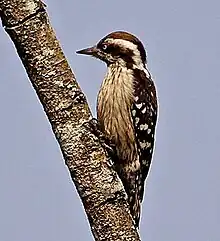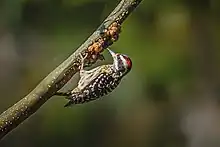| Yungipicus | |
|---|---|
 | |
| Brown-capped pygmy woodpecker Yungipicus nanus | |
| Scientific classification | |
| Domain: | Eukaryota |
| Kingdom: | Animalia |
| Phylum: | Chordata |
| Class: | Aves |
| Order: | Piciformes |
| Family: | Picidae |
| Tribe: | Melanerpini |
| Genus: | Yungipicus Bonaparte, 1854 |
| Species | |
|
7, see text | |
Yungipicus is a genus of woodpeckers in the family Picidae native to Asia. The species in this genus were previously placed in the genus Dendrocopos.
Taxonomy
A molecular phylogenetic analysis of the pied woodpeckers published in 2015 found that the genus Dendrocopos was polyphyletic. In the subsequent rearrangement to create monophyletic genera, seven species were moved to the resurrected genus Yungipicus.[1][2] The genus had been introduced by the French ornithologist Charles Lucien Bonaparte in 1854.[3] The name combines the Ancient Greek iunx meaning wryneck which was used by Carl Linnaeus for his genus Jynx, with the Latin picus meaning "woodpecker".[4] The type species was designated by the English zoologist George Robert Gray in 1855 as a subspecies of the brown-capped pygmy woodpecker, Yungipicus nanus hardwickii.[5] The genus is in the tribe Melanerpini, one of five tribes that make up the woodpecker subfamily Picinae. The genus Yungipicus is sister to the genus Picoides.[6]
The genus includes seven species:[2]
| Image | Common Name | Scientific name | Distribution |
|---|---|---|---|
 | Sulawesi pygmy woodpecker | Yungipicus temminckii | Sulawesi in Indonesia |
 | Brown-capped pygmy woodpecker | Yungipicus nanus | Nepal, India and Sri Lanka. |
 | Grey-capped pygmy woodpecker | Yungipicus canicapillus | Northeast India, Manchuria, eastern Siberia, and Korea. |
 | Philippine pygmy woodpecker | Yungipicus maculatus | Philippines. |
| Sulu pygmy woodpecker | Yungipicus ramsayi | Philippines. | |
_-_Flickr_-_Lip_Kee.jpg.webp) | Sunda pygmy woodpecker | Yungipicus moluccensis | Brunei, Indonesia, Malaysia, and Singapore. |
.JPG.webp) | Japanese pygmy woodpecker | Yungipicus kizuki | Russia, China, Korea and Japan. |
References
- ↑ Fuchs, J.; Pons, J.M. (2015). "A new classification of the pied woodpeckers assemblage (Dendropicini, Picidae) based on a comprehensive multi-locus phylogeny". Molecular Phylogenetics and Evolution. 88: 28–37. doi:10.1016/j.ympev.2015.03.016. PMID 25818851.
- 1 2 Gill, Frank; Donsker, David; Rasmussen, Pamela, eds. (2020). "Woodpeckers". IOC World Bird List Version 10.1. International Ornithologists' Union. Retrieved 24 May 2020.
- ↑ Bonaparte, Charles Lucien (1854). "Quadro dei volucri zigodattili ossia passeri a piedi scansori". In de Luca, Serafino; Müller, D. (eds.). L'Ateneo Italiano; raccolta di documenti e memorie relative al progresso delle scienze fisiche (in Italian). Vol. 2. Parigi [Paris]: Victor Masson. pp. 116–129 [123].
- ↑ Jobling, James A. (2010). The Helm Dictionary of Scientific Bird Names. London: Christopher Helm. pp. 212, 412. ISBN 978-1-4081-2501-4.
- ↑ Gray, George Robert (1855). Catalogue of the Genera and Subgenera of Birds Contained in the British Museum. London: British Museum. p. 91.
- ↑ Shakya, S.B.; Fuchs, J.; Pons, J.-M.; Sheldon, F.H. (2017). "Tapping the woodpecker tree for evolutionary insight". Molecular Phylogenetics and Evolution. 116: 182–191. doi:10.1016/j.ympev.2017.09.005. PMID 28890006.